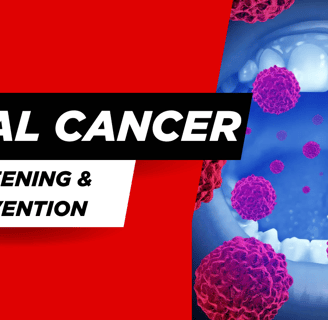Updent Publication: Where Knowledge Meets Innovation.
Oral Cancer Screening and Prevention: Developing new methods for early detection and prevention strategies for Oral Cancers.
The battle against oral cancer requires a multi-faceted approach that combines education, technology, and proactive healthcare. By embracing innovative screening techniques, adopting healthy lifestyle choices, and leveraging the power of AI, we can significantly reduce the burden of this disease.
ORAL CANCER
Haider Afzal
3/25/20253 min read


Oral Cancer Screening and Prevention: Pioneering Early Detection and Prevention Strategies.
Oral cancer is a significant global health challenge, with millions of new cases diagnosed annually. Despite advancements in medical science, oral cancer continues to pose a threat due to late-stage diagnosis and limited awareness. This article dives deeper into innovative methods for early detection, prevention strategies, and the transformative role of artificial intelligence (AI) in combating oral cancers effectively.
Understanding Oral Cancer
Oral cancer encompasses malignancies that develop in the tissues of the oral cavity and oropharynx. It most commonly affects areas such as the lips, tongue, cheeks, floor of the mouth, and throat. The primary risk factors include tobacco consumption (smoking and smokeless forms), excessive alcohol use, human papillomavirus (HPV) infection, poor oral hygiene, and prolonged UV light exposure. The disease has a high mortality rate, primarily because it is often detected in advanced stages.
The Importance of Early Detection
Early detection can dramatically improve survival rates and treatment outcomes. Unfortunately, most cases are diagnosed when cancer has already progressed, making treatment more invasive and less effective. Warning signs that may signal oral cancer include persistent ulcers, unusual lumps, red or white patches, chronic sore throat, and difficulty swallowing.
Promoting regular self-examinations and routine dental check-ups can significantly enhance early detection rates. Dentists often play a critical role in identifying early signs during oral health assessments.
Innovative Screening Methods
1. Fluorescence Imaging: A breakthrough diagnostic tool, fluorescence imaging uses specialized light to highlight abnormal tissues in the oral cavity. This approach helps in detecting precancerous lesions that may be invisible under regular lighting conditions.
2. Salivary Diagnostics: Saliva is emerging as a valuable diagnostic medium. Salivary tests can identify specific biomarkers associated with oral cancer, providing a quick, non-invasive, and cost-effective screening method.
3. Artificial Intelligence (AI): AI-powered technologies are revolutionizing the landscape of oral cancer detection. By analyzing images, such as oral photographs or radiographs, AI tools can identify patterns indicative of cancerous changes with remarkable precision. Machine learning algorithms are also being developed to predict the progression of precancerous lesions.
4. Advanced Imaging Techniques: Techniques like narrowband imaging (NBI) and optical coherence tomography (OCT) are gaining traction for their ability to provide detailed views of oral tissues, aiding in the identification of suspicious areas.
Prevention Strategies
1. Lifestyle Modifications: The cornerstone of oral cancer prevention lies in eliminating risk factors. Quitting tobacco, reducing alcohol consumption, maintaining a balanced diet rich in antioxidants, and practicing proper oral hygiene are essential steps.
2. HPV Vaccination: Vaccines targeting high-risk HPV strains can significantly reduce the risk of HPV-related oral cancers. Public health initiatives should prioritize increasing access to and awareness of these vaccines.
3. Community Awareness Programs: Public education campaigns can bridge the gap in awareness about oral cancer risk factors and early signs. These campaigns should target high-risk populations and emphasize the importance of regular screenings.
4. Regular Dental Visits: Encouraging routine dental check-ups ensures early detection and timely interventions. Dentists can perform comprehensive oral examinations and provide guidance on preventive care.
The Role of Artificial Intelligence (AI) in Oral Cancer
AI is emerging as a game-changer in the fight against oral cancer. Here's how it contributes across different domains:
-Diagnosis and Screening: AI algorithms can analyze vast amounts of data, including clinical images and patient histories, to identify patterns and predict outcomes. Tools like AI-based image recognition systems are being integrated into dental practices, enabling quick and accurate identification of suspicious lesions.
-Predictive Analytics: Machine learning models are being developed to predict the likelihood of cancer progression based on patient-specific factors. This helps in designing personalized monitoring and treatment plans.
-Improving Accessibility: AI-powered mobile applications are making oral cancer screening more accessible in remote and underserved areas. These apps can guide users to take photographs of their oral cavity, which are then analyzed by AI systems for abnormalities.
-Enhancing Research: AI accelerates research by analyzing complex datasets to identify new biomarkers, treatment targets, and trends in oral cancer epidemiology.
The Role of Healthcare Professionals
Healthcare providers, particularly dentists and oral surgeons, are at the frontline of oral cancer prevention and management. With ongoing training and access to advanced diagnostic tools, they can ensure early detection and prompt treatment.
Conclusion
The battle against oral cancer requires a multi-faceted approach that combines education, technology, and proactive healthcare. By embracing innovative screening techniques, adopting healthy lifestyle choices, and leveraging the power of AI, we can significantly reduce the burden of this disease.
As we continue to develop and refine early detection tools and prevention strategies, the future holds promise for a world with lower oral cancer rates and improved patient outcomes. Collaboration between researchers, healthcare providers, and technology developers will be key to achieving this vision. Together, we can create a healthier future, free from the devastating impact of oral cancer.
